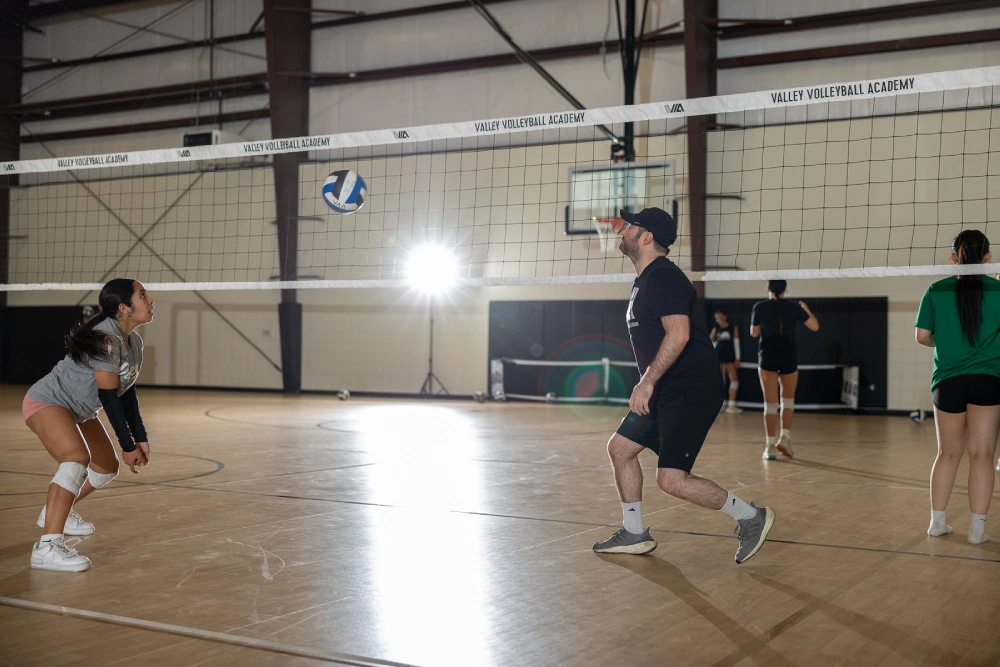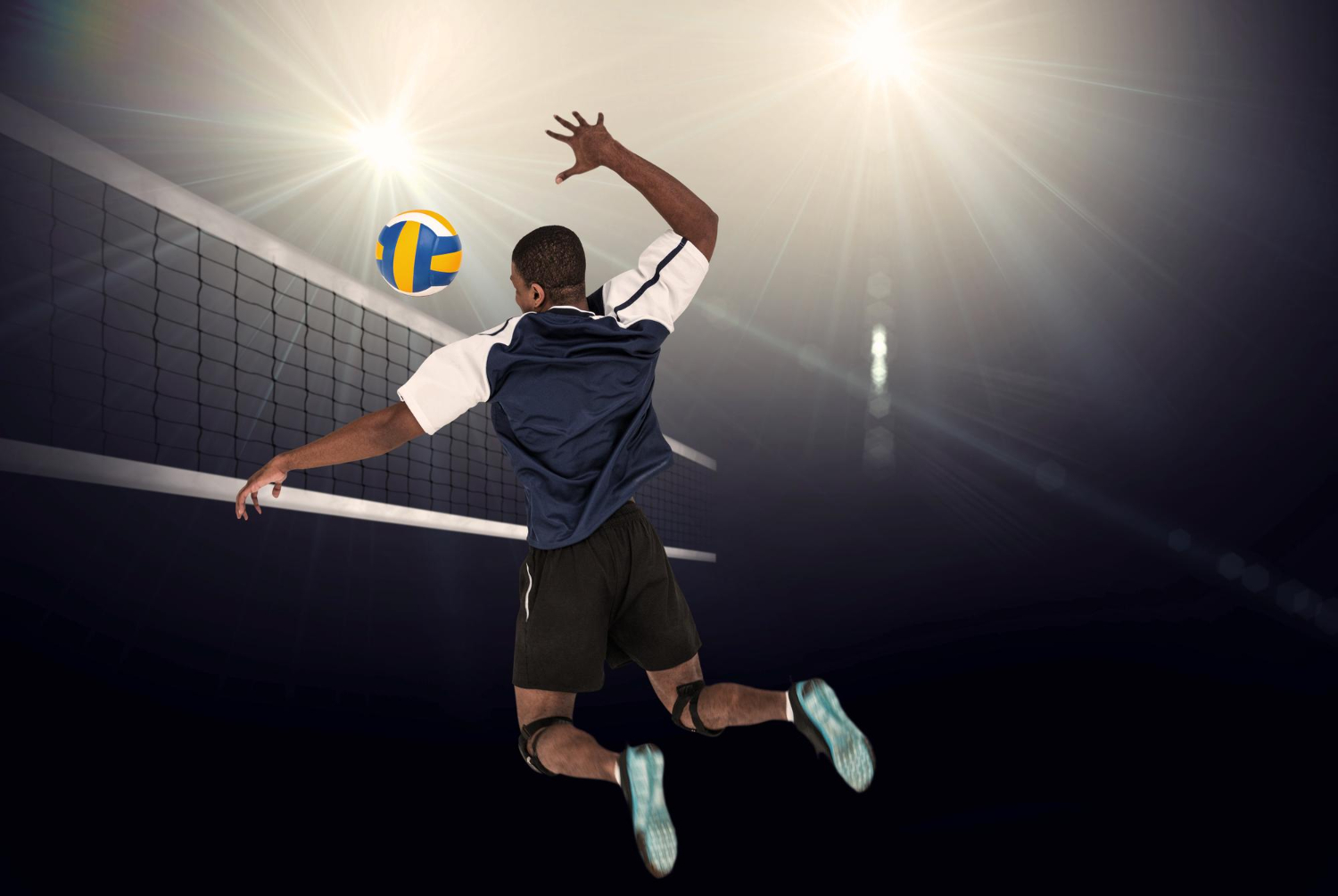Table of Contents
ToggleThe 6-2 volleyball rotation is a popular offensive system that gives teams the advantage of always having three front-row attackers. It uses two setters who rotate through the back row, allowing constant offensive pressure without sacrificing setting consistency. Volleyball rotations play a key role in team success. Whether you’re a coach, player, or facility manager supporting team development, understanding the basics of the 6-2 system can help maximize performance on the court. Let’s break down how to run a 6-2 volleyball rotation, when to use it, and why it’s a favorite among many competitive teams.
What Is a 6‑2 Rotation in Volleyball?
A 6-2 rotation is a volleyball formation that features two setters and six hitters on the court, though only one setter is actively setting at a time. When one setter rotates to the back row, they run the offense while the other serves or plays front-row hitter roles.
Advantages of the 6-2 Volleyball Rotation
The 6-2 rotation offers a powerful blend of offense, flexibility, and player development, perfect for teams that want to keep things dynamic and engaging. Here’s why many coaches and courts favor this system:
-
Strong Right-Side Offense
With two setters rotating, the back-row setter sets while the front-row setter often plays opposite (right side). That setup makes your right-side attack more consistent and effective.
-
Three Front-Row Attackers Always
Since setters set only from the back row, you always have three hitters (outside, middle, right-side) in the front row. That keeps the offense powerful and unpredictable throughout the match.
-
Optimized Substitutions for Offense
When a setter rotates to the front, you can sub in a stronger hitter. That keeps your front-row offense sharp under pressure and makes substitutions strategic and effective.
-
Better Playing Time & Less Burnout
Using two setters means each plays only in the back row. This divides the workload so they stay focused and energetic, especially in longer matches. It also gives more players court time, great for youth and developmental teams.
-
Flexible Attacking Options
With six potential hitters, you can mix up your offense. Whether it’s quick middle attacks or high-tempo right-side sets, 6-2 gives coaches more tactical freedom.
-
Easier to Learn Rotations
Players only need to memorize three serve‑receive patterns, which makes the system much easier to master, especially helpful at schools or clinics.
-
Effective Blocking Strategy
Having three front-row attackers also gives you three blockers at the net, crucial for slowing down the opponent’s offense and keeping them guessing
-
More Consistent Sets
Because setters only work from the back row, they can focus entirely on their ball-handling and distribution. This consistency leads to a more reliable offense and fewer rushed plays
The 6-2 rotation is a strong choice if your team has two good setters and plenty of hitters. It delivers stability, variety, and a system that grows with the players, ideal for facility-led training sessions or competitive environments.
Disadvantages of the 6-2 Volleyball Rotation
While the 6-2 system offers powerful offensive options, it comes with some trade-offs that coaches, players, and facility managers should consider before using it.
-
Requires Two Skilled Setters
You need two setters who are consistently strong and reliable. Switching between them can confuse hitters and disrupt offensive rhythm.
-
No Front-Row Attacks or Blocks from Setters
In a 6-2 rotation, setters always stay in the back row, so they can’t attack or block at the net. If they instinctively jump, it leads to penalties, potentially costing points.
-
Harder to Get into the Setting Position
Back-row setters must cover more court and navigate rotations to reach their target setting spot. This can slow down offensive plays, especially after a 6-2 volleyball rotation serve receive.
-
Uses More Substitutions
Often, coaches will sub front-row setters for stronger hitters. But that eats up valuable substitution slots, and running out can force the team into less optimal formations.
-
Set Consistency Can Suffer
Because hitters interact with two different setters, timing and expectations can vary. That inconsistency sometimes leads to mistimed sets and unexpected errors..
-
Common and Predictable
The 6-2 is widely used, especially at intermediate levels. This means opponents are familiar with its patterns and may adapt effective defences against it.
-
Challenging for Less Experienced Teams
Between mastering two setters, substitutions, and rotation responsibilities, the 6-2 can feel complex for newer teams, especially those still working on solid passing and communication.
Although the 6-2 delivers consistent offensive strength, it demands setter depth, smart rotation management, and disciplined players. It tends to work best for teams with solid organizational structure, whether that’s in a competitive club setting or a well-supported facility training program.
New to rotations? Check out other volleyball rotation strategies.
Understanding the 6‑2 Rotation: Player Positions and Roles
To run a smooth 6-2 system, every player needs a clear role and a position that maximizes the team’s offense and defence. Below are the key roles and responsibilities:
- Setter (2): There are two setters, but only the back-row player runs the offense. Their job is to position the ball perfectly for each hitter. When they rotate to the front row, one of the hitters’ steps in or a substitute comes in.
- Opposite or Right-Side Hitter: Located opposite the setter, this player is usually in position 2 when in the front row. They help with blocking and are a strong attacking option from the right side
- Outside Hitters (2): There are two outside hitters, one on the left side (Position 4) and another in the opposite rotation spot (H2). They’re the primary attackers on the left side and also take part in serve-receive and defence from the back row.
- Middle Hitters (Middle Blockers) (2): These players focus on quick attacks and blocking in the center. They rotate in and out, but when up front, they’re key for fast-paced offense and core defence coverage
- Libero: The libero is the defensive anchor. They replace back-row players, handle most of the serve-receive, and anchor the defence without counting against substitutions
- Defensive Specialist (DS): Like the libero, the DS substitutes into the back row to assist with defence and serve-receive. They’re a flexible option to support the libero or settle the defence
By clearly defining each position and role, the 6-2 rotation ensures that teams always have three front-row attackers, a dedicated set-up from the back, and strong back-row defence. Let me know if you’d like to add visual court layouts or clarify substitutions for your facility’s training guides.
How Does a 6‑2 Rotation Work in Volleyball?
Understanding the mechanics of the 6-2 rotation helps coaches, players, and facility managers run tight, effective sessions every time. Here’s a clear breakdown based on current explanations:
Basics of the 6‑2 System
- The back-row setter always sets from a spot just behind the 10-foot line, two feet off the net, just right of center. No matter where the serve-receive ends up, the setter aims to reach this consistent spot for reliable ball distribution.
- After serve-receive begins, each player moves into their pre-assigned positions: setters head toward their setting zone, while attackers prepare to approach, ideally before or as the ball crosses the net.
- Only the back-row setter controls the offense. When the setter rotates forward, a designated hitter or substitute comes in up front, keeping three attackers at all times
- Coaches design serve-receive formations to “hide” the setter, making sure they’re protected and positioned for the first set
Rotational Flow: What Happens Each Turn
- Rotate Clockwise: Every time your team wins a rally and gains serve, players shift one spot in a clockwise pattern.
- Back-Row Setter Takes Over: Once the setter lands in the back row, they immediately move into position to set.
- Front-Row Substitution: As the setter moves up front, a hitting specialist or opposite usually replaces them to keep three strong attackers at the net.
- Consistent Structure: This rotation pattern repeats every six serves, maintaining a structure with always one active setter behind the 10-foot line and three powerful attackers upfront.
Challenges and Solutions in the 6‑2 Rotation
While the 6-2 rotation brings lots of offensive strength, it comes with some hurdles that coaches, players, and facility managers should be aware of. Here’s how to tackle them head-on:
-
Requires Two Skilled Setters
- Challenge: You need two setters who are consistently capable; there’s no room for weak links. Switching your active setter mid-game can also disrupt player rhythm.
- Solution: Invest in focused development for both setters. Practice their rotations and timing equally so each can seamlessly lead the offense without missing a beat.
-
No Front-Row Attacks or Blocks from the Setter
- Challenge: Setters are always in the back row, meaning they can’t attack or block at the net. Teams might miss out on surprise plays like setter dumps.
- Solution: Teach hitters to maximize front-row presence and use strong hitters to maintain offensive firepower. And train your setters to stay disciplined and avoid front-row violations.
-
Longer Transition to Setting Position
- Challenge: Back-row setters often need to travel across the court after serve receive, which can slow down the offense.
- Solution: Drill rapid footwork and serve-receive setups that hide the setter in a consistent location. Libero and defensive specialists can also support better passer options to speed things up.
-
Increased Substitution Complexity
- Challenge: To keep three strong hitters in front, setters often need front-row subs, which can eat up substitution slots and create logistical headaches.
- Solution: Plan subs carefully around rotations, and use options like double-sub rotations (front row setter replaced by an opposite) to balance your lineup and manage sub limits.
-
Inconsistent Setter–Hitter Chemistry
- Challenge: Hitters must adjust to two different setters, which can lead to timing issues and miscommunication.
- Solution: Rotate practice sessions so hitters work with both setters equally. Use communication drills, and let setters refine their speed and style for smooth handoffs.
-
Opponent Familiarity and Predictability
- Challenge: The 6‑2 is common at many levels, meaning opponents may anticipate its rotations and target weaknesses.
- Solution: Add offensive variety through quick sets, setter dumps, and strategic subs. Keep opponents guessing by alternating attack tempos and hitting locations.
-
Complexity for Newer Teams
- Challenge: The system involves tracking two setters, substitutions, and rotational nuances, which can overwhelm less experienced players.
- Solution: Break it down step-by-step. Use visuals, walk-throughs, and handouts. Start with core rotations before adding subs. Assign student leaders or experienced players to help guide teammates during games.
The 6-2 rotation delivers powerful front-row offense and flexible subbing but demands setter depth, strategic planning, and strong player coordination. By training smart, using visual aids, and prioritizing communication, any team or training program can master its flow and feel confidently competitive on the court.
Final thoughts
The rotation 6-2 volleyball is a dynamic and offense-heavy system that’s perfect for teams looking to maximize their attacking power. By always having three front-row hitters and two setters ready to run the offence, it gives teams flexibility, variety, and depth. While it does come with challenges, like complex rotations and the need for strong setter-hitter chemistry, these can be managed with the right training, smart substitutions, and strong communication.
For sports facilities and coaches, teaching the 6-2 system can be a great way to elevate your teams’ competitive edge while giving more players meaningful roles on the court. With the right preparation, this rotation can turn potential into performance.
Curious about volleyball rotation strategies? Learn them and more by joining our Volleyball Programs today!
FAQs: Understanding the 6-2 Volleyball Rotation
Q: Is the 6-2 rotation a good fit for all skill levels?
The 6-2 system works best for teams with more developed players. It requires solid setters and strong hitters who can handle the fast pace and rotation shifts. Beginners might find it a bit complex at first, so starting with a simpler system like the 4-2 or 5-1 can sometimes be a better choice for learning the basics.
Q: What’s the biggest difference between a 6-2 and a 5-1 rotation?
It really comes down to the number of setters. In a 5-1, you have one main setter running the offense throughout all rotations. In a 6-2, two setters only set when they’re in the back row—this means your team always gets three front-row hitters, keeping the offense strong and aggressive.
Q: How do teams usually handle substitutions in a 6-2?
Substitutions in the 6-2 are all about keeping the offense balanced. Typically, one of your back-row setters swaps in for a front-row hitter and vice versa. Since volleyball has a substitution limit, especially at certain levels, coaches have to plan ahead to keep the system running smoothly.
Q: Does using a 6-2 automatically make the offense better?
Not always. The setup gives your team the option for a stronger offense, but its success depends on how well the players communicate, transition, and execute plays. If the timing is off or players aren’t sure of their roles, it can cause more problems than benefits.
Q: What are some mistakes teams should avoid when using a 6-2 system?
Some common slip-ups include: setters struggling with back-row setting angles, hitters not adjusting to the new tempo, confusion during quick transitions, and gaps in blocking coverage. It’s important to practice these situations regularly so everyone stays on the same page.
Authors
-
Sarah Baker is a dedicated sports and fitness content specialist with a rich background in athletics. As a former high school volleyball player and track athlete, she understands the transformative power of sports in shaping character and fostering discipline. Sarah is passionate about inspiring youth worldwide to embrace sports, hone their skills, and achieve excellence both on and off the court. She continually expands her knowledge through ongoing education in sports performance and fitness, aiming to empower her audience with valuable insights. Currently, Sarah contributes her expertise to the content team at Valley Athletics, a premier sports facility in Fresno, California, dedicated to developing young athletes in volleyball, basketball, and pickleball.
View all posts -

Jonathan stands as a monumental figure in volleyball, boasting accolades such as National Champion, National Player of the Year, and being one of the select few, just thirteen, to achieve All-American status four times in NCAA volleyball history. His illustrious playing journey took flight at Pepperdine University, culminating in his 2005 NCAA Championship win, AVCA National Player of the Year and Newcomer of the Year titles.
View all posts



